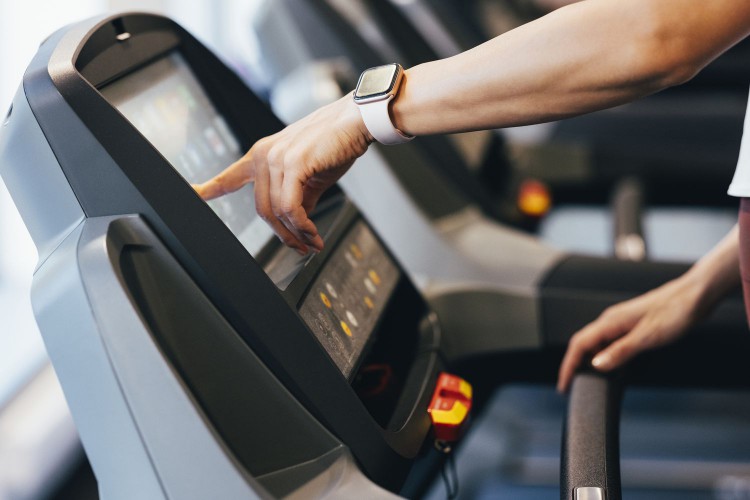‘Fat-Burning Zones' on Cardio Gym Equipment Often Inaccurate
- New research shows “fat-burning zone” recommendations on commercial cardio equipment may not provide accurate information.
- For information on how to best burn fat, people should rely on clinical exercise tests or other, more individualized heart rate data.
- Experts note that exercise is only one piece of the puzzle when it comes to fat loss—diet, hydration, and other lifestyle factors play a role in successful weight loss.

FreshSplash/Getty Images
The “fat-burning zone” recommendations on commercial cardio equipment may be leading people astray, a new study finds.
Many pieces of commercial cardio equipment recommend that people stay within a certain heart rate range in order to enter a “fat-burning zone” as they exercise. However, new research found that those metrics may not be accurate for every person.
Researchers out of Mount Sinai’s Icahn School of Medicine looked at data from 26 participants and tracked their heart rate and peak fat-burning rate during exercise. They found that individuals’ optimal heart rate for burning fat often varied widely from what exercise machines’ fat-burning zones recommended for them.
“The ‘one-size-fits-all’ approach for exercise that is often used in the field can result in many individuals exercising at intensities that are inconsistent with their goals,” Hannah Kittrell, RD, lead study author and director of the Physiolab at the Icahn School of Medicine at Mount Sinai, told Health.
Rather than relying on heart rate recommendations from these fat-burning zones, people may want to seek out more individualized guidelines if they’re looking to lose weight.
Kittrell suggests tests that measure a person’s physiological response to exercise may be “useful [tools] for tailoring ‘precision’ exercise prescriptions.”
Here’s what experts had to say about why cardio machines’ fat-burning zones may be inaccurate, and ways that people can optimize their own individual fat loss.
Using Metrics to Understand Fat-Burning Execution
Kittrell and the other researchers wanted to examine how each of the study participants’ optimal heart rate for fat loss compared with what was suggested by cardio machines’ fat-burning zones.
In order to make this comparison, subjects were given a clinical exercise test to measure their Fatmax—this is short for “maximum fat oxidation rate,” explained Haley Perlus, PhD, fitness coach and sport and exercise psychologist.
The term refers to “the intensity at which your body burns the highest amount of fat calories per minute,” she told Health.
This number represents a single exercise intensity, Kittrell said, in contrast to traditional fat-burning zones, which recommend a range of some percentage of a person’s max heart rate.
More specifically, the fat-burning zone is meant to elevate a person's heart rate up to 60% or 70% of its maximum, Tracie Massey, a certified personal trainer and manager of Fredericksburg Fitness Studio, told Health.
“Typically, about 65% of the calories you burn in this zone are from fat,” she said.
A person’s maximum effort in this fat-burning zone would be their Fatmax number. However, the study found that this isn’t always the case.
Fat-burning zones recommended by exercise machines are often based on age, heart rate, and sex. But even after taking these factors into consideration, they don’t always do a good job of predicting a person’s Fatmax.
Kittrell offered an example in a press release: Two participants were told that their fat-burning zone would be between 55% to 75% of their max heart rate. However, after doing the clinical exercise test, the researchers found that one participant’s actual Fatmax was 50% max heart rate, while the other’s was 80%.
If both strictly followed the fat-burning zone recommendations on exercise equipment, one would be working out too intensely, while the other would be working out too leisurely. Neither participant would be burning fat most efficiently.
The study authors found an average difference of 23 beats per minute between a person’s predicted fat-burning zone and their actual Fatmax score.
How to Calculate Your Body Fat Percentage
A Better Way to Measure Optimal Fat-Burning
Though frustrating for people who typically rely on the fat-burning zone metrics on their workout equipment, the results of the study aren't actually that shocking, Perlus explained.
“Our bodies are complex and respond differently to exercise, making it reasonable to expect that the optimal heart rate for fat burning can vary among individuals,” she said.
Because of this, a more individualized process might be more effective if a person wants to know how to most efficiently lose weight through exercise—the study authors offered up clinical exercise tests as one possible alternative.
Clinical exercise tests—which were also conducted during the study itself—evaluate a number of physiological parameters, such as heart and lung capacities, as well as physical ability, said Massey.
“It’s typically conducted in a medical or research setting and provides valuable information about how the body burns fat during different exercise intensities,” she said. Experts can get this information during walk tests, shuttle walk tests, cardiac stress tests, and more.
These kinds of “ class="comp mntl-sc-block healthdotcom-sc-block-heading mntl-sc-block-heading"> Fat Loss Beyond the Numbers
According to Perlus, individualized heart rate recommendations for fat loss may certainly be helpful, but this data may not be necessary for every person who’s trying to lose weight.
“Practical lifestyle changes, including a balanced diet and regular physical activity, remain the foundation of effective and sustainable fat loss,” she said.
Even more so than exercise, nutrition usually plays the biggest role in burning fat, Steven Batash, MD, a gastroenterologist currently affiliated with NYU Medical Center, Lenox Hill Hospital, and NewYork-Presbyterian Hospital, told Health.
“People who are mostly interested in achieving weight loss goals should start with their diet and incorporate moderate exercise that they enjoy doing to achieve long-term weight loss,” he said.
Perlus recommended people strive for a balanced diet with lean proteins, whole grains, and healthy fats. Portion control and balanced food choices are also “essential for utilizing stored fat as energy,” she said.
When it comes to physical activity for fat loss, experts agree that it’s best to focus on a combination of cardiovascular exercises and strength training to build lean muscle mass. Cardio may be typically thought of as the best exercise to lose weight, but any activity that gets a person’s heart rate into a fat-burning zone will work, Kittrell said.
“Cardio burns more calories during your workout, while strength training helps you build muscle so that you’ll burn more calories 24/7,” Batash said.
Current physical activity guidelines recommend that adults should get 150 minutes of moderate-intensity physical activity and two days of muscle-strengthening activity.
Specifically, high-intensity interval training (HIIT) may be a good addition to people’s workout routines if they’re looking to burn fat, Perlus said. For a more tailored fat loss plan, Massey suggested personal trainers may be helpful.
Ultimately, burning fat looks different for every person. And since the most effective weight loss plans are often ones that are balanced, avoid focusing on just one rule, Massey recommended.
In addition to exercising and eating a nutritious diet, she said to prioritize good sleeping habits, stay hydrated, and seek out services from a qualified medical fitness specialist or personal trainer for clinical exercise testing to find your fat-burning sweet spot.
How To Lose Fat With Strength Training








